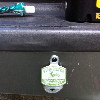overripeturnip
Member
- Joined
- April 4, 2017
- Messages
- 22
- Reaction score
- 0
- City, State
- Littleton, CO
- Year, Model & Trim Level
- 92 Explorer XLT 4x4
Hey guys, I've been trying to get my AC working today. The previous owner claimed to have converted it to R134a and, when I bought it from him, said the AC had worked for a while when he last recharged it but suspected one of the lines was weeping. I bought some new 4seasons lines, an accumulator and a orifice tube expecting to find the system already empty. To my surprise, I hooked up my AC gauges and discovered the LP valve read 80psi. It seems the previous owner only fitted a R134a adaptor to the low side, and so I was unable to do any 'dynamic' readings straight away. I fired the old girl up and the compressor clutch failed to engage. After a lot of poking about jumping the low pressure connector and the clutch connector itself to no avail, I checked the clutch air gap. It was measuring around 0.060". I removed a shim and managed to bring this within spec (down to around 0.025"), which started the clutch engaging and I thought this was gonna be the world's easiest fix. A quick trip to O'Reilly's produced a HP valve adaptor and I was finally able to hook up my gauges for some proper diagnosis.
I'm pretty sure the compressor is done for. The LP side seems far too high and isn't cycling. I had everything on max (Max A/C + full blower), but both gauges sat at roughly the same pressure the whole time. I tried to show in the video the sounds coming from the compressor itself. It's making quite a racket. Even as I'm typing this, I realise I've pretty much convinced myself to replace it, but I would appreciate a second opinion from somebody a little more experienced. I just don't want to throw more money at this if the compressor's not the problem.
I'm pretty sure the compressor is done for. The LP side seems far too high and isn't cycling. I had everything on max (Max A/C + full blower), but both gauges sat at roughly the same pressure the whole time. I tried to show in the video the sounds coming from the compressor itself. It's making quite a racket. Even as I'm typing this, I realise I've pretty much convinced myself to replace it, but I would appreciate a second opinion from somebody a little more experienced. I just don't want to throw more money at this if the compressor's not the problem.










